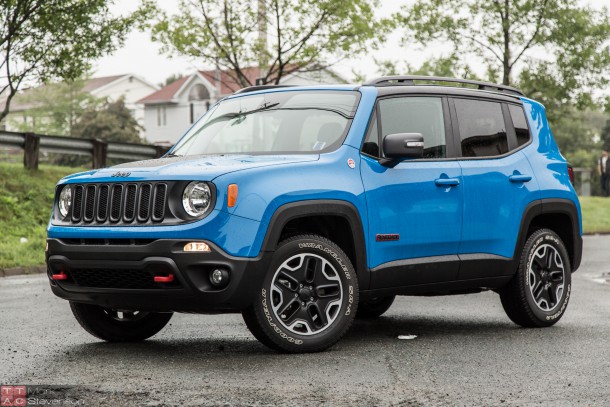By Shari Prymak
The Wrangler defines the Jeep brand better than any other model in the lineup. Many are drawn to its nostalgic design, open top freedom, and rugged, go anywhere capability. Unfortunately, the qualities for which it is loved are the source of a wide range of issues for daily usability as well. Road noise, cumbersome handling, and woeful fuel efficiency are all noteworthy parts of Wrangler ownership. That’s where the Renegade comes in.
The Renegade is Jeep’s attempt to create a subcompact crossover that captures the essence of the Wrangler, yet does so without its drawbacks. Part of this can be seen in the Renegade’s design. It has the same boxy rugged look of the Wrangler, though admittedly in a more Tonka Toy sort of way. The interior too is full of interesting touches and neat details that draw on the Jeep heritage. There are plenty of well-designed touches such as the Uconnect infotainment system which is one of the best in the market. The most notable drawback is skimpy rear seat space which makes transporting tall adults a challenge.
The Renegade may attempt to mimic the Wrangler when it comes to design, but there’s no mimicry when it comes to on-road manners. The ride and handling compromise is just about right for a daily-driver, and the cabin is largely free of road noise. It’s also quite city-friendly with good maneuverability and tidy dimensions for easy parking. Despite its civil on-road manners, the Renegade can still tackle the off-road when the appropriate options are selected. That’s something that certainly cannot be said of many of its competitors.
The entry level models make use of a 2.4L 4-cylinder engine matched to a 9-speed automatic transmission and front-wheel drive. Most Renegade shoppers will likely be drawn to the optional 1.3L turbocharged 4-cylinder with its Active Drive 4x4 system. Trailhawk models also get a Selec-Terrain traction management system and two-speed transfer case with a 21:1 crawl ratio for more off-road capability. Despite the respectable figures of 177 horsepower and 200 lb-ft torque, the 1.3L never really feels anything more than adequate in terms of performance. On the plus side, it is capable of sipping as little as 7.0L/100km on the highway.
The Renegade more or less succeeds at delivery the Jeep experience in a more compact, city-friendly package when compared to its big brother Wrangler. Unfortunately, it does so with some very ambitious pricing. The entry-level Sport model starts at $28,445 and comes fairly barebones for that amount. Move up the trim levels while tacking on desirable options such as the dual-pane sunroof, Beats audio system, and active safety technology, one can option a Renegade to as much as $45,000 before fees and taxes. In a world where many well-equipped compact crossovers can be had in the mid to high $20,000 range, Jeep is really banking on consumers paying a hefty premium for those Jeep qualities.
Those seeking a compromise between a sensible small crossover and a go-anywhere Wrangler might be pleased with the Renegade. One would really have to seriously want that Jeep image and off-road antics, however, to swallow that price tag. To put things in perspective, my 2019 Nissan Kicks SR test car from the week prior had an MSRP of $23,398. It even came with enough space, on-road performance, and features to just rival that of my $40,000 Renegade tester. I get that the Kicks isn’t a Jeep, but by any rational method of analysis, we’re talking some serious price disparity here for two crossovers competing in a similar space. The question then becomes, how much extra is that “Jeepness” worth to you? For the average compact crossover shopper, I suspect not as much as Jeep thinks.

